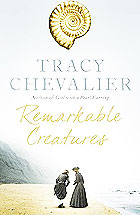from the Guardian by Ruth Padel
"New life is formed from extinction and death," wrote Darwin in 1838, in a private notebook. Some 20 years later, he based The Origin of Species on the fact that fossils document a continuum of life forms, demonstrating that millions of species died out as others took their place. A generation earlier, however, when Tracy Chevalier's rough-petticoated heroine was pulling out of cliffs in Lyme Regis the evidence that would go into this insight, nobody wanted to believe that God did not, as one of Chevalier's characters puts it, "plan out what He would do with all of the animals He created".
It is a stunning story, compassionately reimagined. In real life Chevalier's heroine, Mary Anning, was the greatest fossil-hunter ever. Her father was a not-very-successful cabinet-maker whom Jane Austen once asked to mend a chest, but his estimate was too high. Austen looked elsewhere, never knowing that the artisan she briefly met was teaching his gifted daughter to find the "curies", the fossil curiosities sold to Lyme tourists like herself.
As a young child, Mary survived a lightning strike, which people said made her strange and extra bright. She had an uncanny gift for finding fossils, was the origin of the tongue-twister "She Sells Sea Shells on the Sea Shore", and in 1811 when she was 12 (Darwin was two) her first big find, a "crocodile" later named ichthyosaurus, rocked the scientific world. She unearthed a plesiosaurus in 1823, a pterodactyl in 1828 and a squaloraja (a transition fish, between sharks and rays) in 1829.
Scientists were knocking at Mary's impoverished family's door from 1811. Even before Richard Owen coined the word dinosaur, "terrible lizard", in 1824, giant fossils were a hot scientific topic. Several male scientists owed their achievements to Mary's finds. She taught herself geology and anatomy and worked out, with the Oxford geologist William Buckland, that lumps known as bezoar stones were actually dinosaur faeces. To raise money for Mary, one patron, Colonel Birch, auctioned the fossils she helped him find. Later the French scientist Cuvier accused Mary of fraud, a charge she successfully rebutted. She died unmarried at 47, with the respect of the international scientific community. READ MORE....
Subscribe to:
Post Comments (Atom)



No comments:
Post a Comment